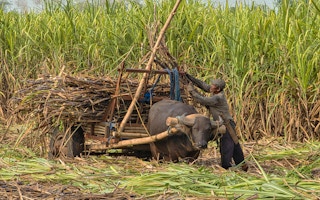Researchers have once again warned that climate change is likely to mean a hungrier world with less food on the table: by 2050, global crop yield could have fallen by 10 per cent. And by the century’s end − and with a much larger burden of human population − farmers might be producing 25 per cent less than they do now.
The calculations come just a few weeks after a separate team of scientists predicted that uncontrolled global heating driven by continued profligate use of fossil fuels might change the global climate in ways that could cut harvests by as much as a third.
Food is not separable from climate change: modern agriculture and the global appetite for animal products is both a major contributor to ever-greater greenhouse gas emissions and, in very different ways, a potential answer to some of those challenges.
Demand for food for ever-greater numbers of increasingly wealthier people has driven the destruction of forests, savannahs and wetlands that nurse life’s variety, underwrite the planet’s economy, and buffer nations against climate change.
But researchers have also found, again and again, that with a different mindset and a shift of global appetite, it might be possible to feed 10 billion people and preserve the planet’s biodiversity.
“
If difficulties to adapt are observed in the US, what can we then expect of food producers in the tropics.
Enrica de Cian, associate professor in environmental economics, Ca’Foscari University
That is based on an assumption that climate change fuelled by greenhouse gas emissions doesn’t change the nature of farming. And, increasingly, researchers believe that it will.
There has been repeated evidence that higher temperatures and rainfall shifts can reduce not just total yields, but also nutritional value. And the pattern of heatwave and drought promised by ever-rising temperatures suggests the possibility not just of local but of global famine.
Scientists from the US and from Italy report in the journal Environmental Economics and Management that they matched their climate simulations with weather records from the past and applied them to 21 different forecasts of changes in temperature and rainfall, and the potential impact of these changes on just four staples: maize, rice, soybean and wheat. These four crops account for three-fourths of the world’s calorie supply.
Hesitant adapters
Farmers expect to be confronted by unwelcome weather, not least in an ever hotter and hungrier world. All the evidence is that heat waves, drought, windstorm and flooding are likely with time to become more extreme and more frequent. So how farmers have adapted in the recent past to shifts in the climate in the last few decades might provide an answer as to their preparedness to adapt to the new world.
The new study suggests they may not adapt fast enough or surely enough. The researchers find that three decades from now, the global harvest could be 3 per cent less than it is now, or as much as 11 per cent. By 2100, yields may have fallen by 11 per cent, or as much as 25 per cent.
“Globally, farmers’ capacity to adapt to climate change impacts, even over longer periods, might be limited,” said Ian Sue Wing of Boston University in the US. “Even in the United States, the world’s agricultural technology frontier, farmers have been able only slightly to compensate for the adverse impacts of extreme heat on yields of maize and soybeans over time-frames of decades.”
And his co-author Enrica de Cian of Ca’Foscari University in Venice, Italy said: “We asked ourselves: if difficulties to adapt are observed in the US, what can we then expect of food producers in the tropics, where 40 per cent of the world’s population live and high temperature extremes are projected to rise more than in the major calorie crop-growing regions of the US?”
This story was published with permission from Climate News Network.










